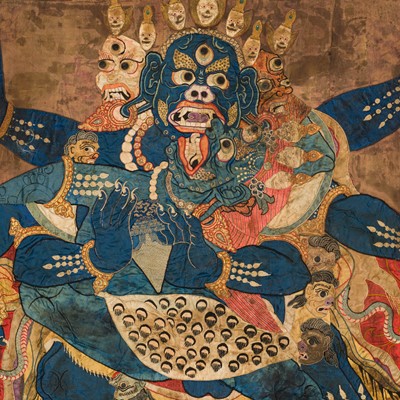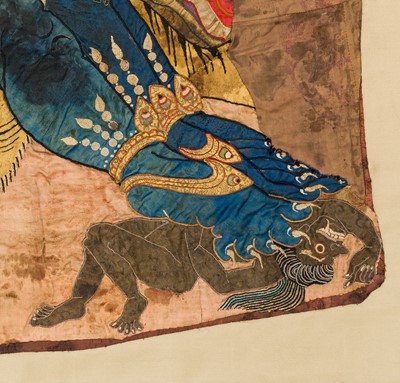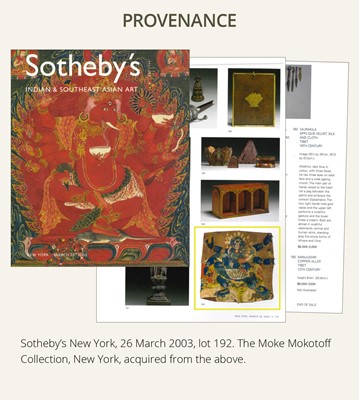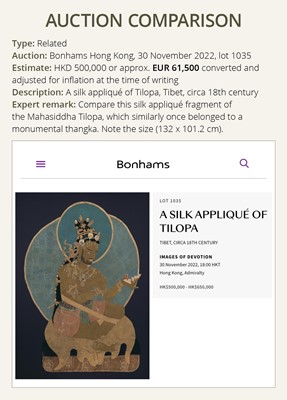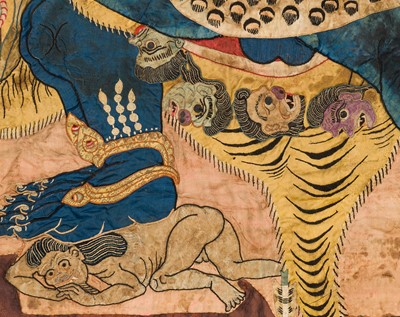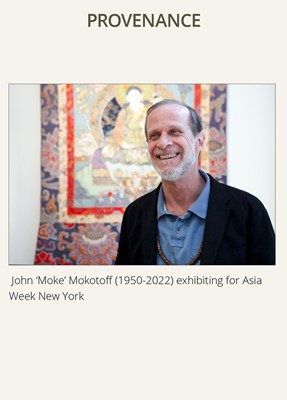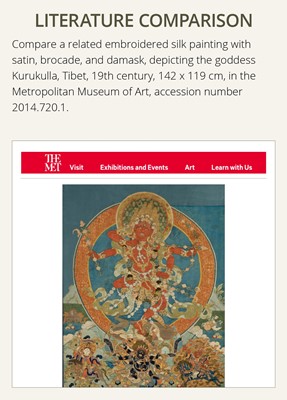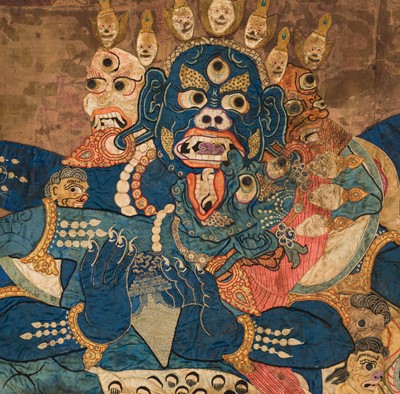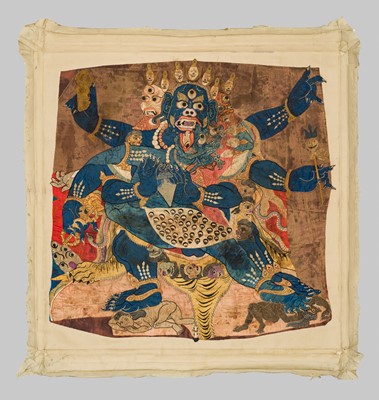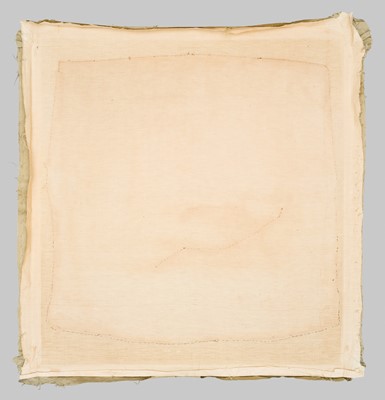11th Apr, 2024 11:00
TWO-DAY AUCTION: Fine Asian Art, Buddhism and Hinduism
29
A LARGE AND DRAMATIC SILK APPLIQUÉ OF VAJRAKILAYA WITH CONSORT, TIBET, 18TH CENTURY
Sold for €28,600
including Buyer's Premium
Silk and velvet appliqué with silk embroidery mounted onto a cloth backing. The wrathful three-headed deity with a dark blue body and six arms, embracing his consort Diptachakra and standing in alidhasana atop Ishvara and Uma, grasping a kila in the primary hands, with two vajras and a trident in the secondary and tertiary hands, wearing a tiger hide as well as human and animal skins as lower garments, his heads adorned with skull tiaras.
Provenance: Sotheby’s New York, 26 March 2003, lot 192. The Moke Mokotoff Collection, New York, acquired from the above. John ‘Moke’ Mokotoff (1950-2022) was a devoted Buddhist practitioner, passionate collector, and esteemed dealer of Asian art. After studying expressive art and photography in school, he moved to New York, where he began to deal in the nascent market for Chinese, Indian, and Himalayan art. In 1980, Moke opened his first gallery, Mokotoff Asian Arts, and actively sold important works to some of the most prominent collections in New York and globally, including the Metropolitan Museum of Art and the Rubin Museum of Art. Revered for his knowledge of Chinese and Indian textiles, Moke was also a compassionate teacher and lifelong patron of Buddhist monasteries and nunneries.
Condition: Good condition, old wear, soiling, browning, stains, minor losses, small tears, loose threads, possibly minor repairs.
Dimensions: Size 88 x 88 cm
This appliqué was once just a small component of a monumental thangka. Tibetan monasteries stored vast scrolled images that were unfurled down steep mountainsides or tall buildings for public viewing on ceremonial occasions, see Zwalf, Art of Tibet, 1981, p. 68. Tibetans are expert needle-workers but do not themselves produce silk fabric. The silks used in this appliqué and embroidered picture are Chinese; Tibetan monasteries often had stocks of fine and antique Chinese silks to use as required, see David Weldon and Jane Casey, Faces Of Tibet: The Wesley and Carolyn Halpert Collection, Carlton Rochell, New York, 2003.
Vajrakilaya, also known as Vajrakumara, is identified by the kila or three-sided peg held with his two main hands at his heart. Emanating as a meditative deity, his practice is celebrated for its ability to remove obstacles and adversarial forces that impede spiritual advancement. He is believed to be the wrathful manifestation of the karma-purifying deity Vajrasattva.
Literature comparison:
Compare a related embroidered silk painting with satin, brocade, and damask, depicting the goddess Kurukulla, Tibet, 19th century, 142 x 119 cm, in the Metropolitan Museum of Art, accession number 2014.720.1.
Auction result comparison:
Type: Related
Auction: Bonhams Hong Kong, 30 November 2022, lot 1035
Estimate: HKD 500,000 or approx. EUR 61,500 converted and adjusted for inflation at the time of writing
Description: A silk appliqué of Tilopa, Tibet, circa 18th century
Expert remark: Compare this silk appliqué fragment of the Mahasiddha Tilopa, which similarly once belonged to a monumental thangka. Note the size (132 x 101.2 cm).
Silk and velvet appliqué with silk embroidery mounted onto a cloth backing. The wrathful three-headed deity with a dark blue body and six arms, embracing his consort Diptachakra and standing in alidhasana atop Ishvara and Uma, grasping a kila in the primary hands, with two vajras and a trident in the secondary and tertiary hands, wearing a tiger hide as well as human and animal skins as lower garments, his heads adorned with skull tiaras.
Provenance: Sotheby’s New York, 26 March 2003, lot 192. The Moke Mokotoff Collection, New York, acquired from the above. John ‘Moke’ Mokotoff (1950-2022) was a devoted Buddhist practitioner, passionate collector, and esteemed dealer of Asian art. After studying expressive art and photography in school, he moved to New York, where he began to deal in the nascent market for Chinese, Indian, and Himalayan art. In 1980, Moke opened his first gallery, Mokotoff Asian Arts, and actively sold important works to some of the most prominent collections in New York and globally, including the Metropolitan Museum of Art and the Rubin Museum of Art. Revered for his knowledge of Chinese and Indian textiles, Moke was also a compassionate teacher and lifelong patron of Buddhist monasteries and nunneries.
Condition: Good condition, old wear, soiling, browning, stains, minor losses, small tears, loose threads, possibly minor repairs.
Dimensions: Size 88 x 88 cm
This appliqué was once just a small component of a monumental thangka. Tibetan monasteries stored vast scrolled images that were unfurled down steep mountainsides or tall buildings for public viewing on ceremonial occasions, see Zwalf, Art of Tibet, 1981, p. 68. Tibetans are expert needle-workers but do not themselves produce silk fabric. The silks used in this appliqué and embroidered picture are Chinese; Tibetan monasteries often had stocks of fine and antique Chinese silks to use as required, see David Weldon and Jane Casey, Faces Of Tibet: The Wesley and Carolyn Halpert Collection, Carlton Rochell, New York, 2003.
Vajrakilaya, also known as Vajrakumara, is identified by the kila or three-sided peg held with his two main hands at his heart. Emanating as a meditative deity, his practice is celebrated for its ability to remove obstacles and adversarial forces that impede spiritual advancement. He is believed to be the wrathful manifestation of the karma-purifying deity Vajrasattva.
Literature comparison:
Compare a related embroidered silk painting with satin, brocade, and damask, depicting the goddess Kurukulla, Tibet, 19th century, 142 x 119 cm, in the Metropolitan Museum of Art, accession number 2014.720.1.
Auction result comparison:
Type: Related
Auction: Bonhams Hong Kong, 30 November 2022, lot 1035
Estimate: HKD 500,000 or approx. EUR 61,500 converted and adjusted for inflation at the time of writing
Description: A silk appliqué of Tilopa, Tibet, circa 18th century
Expert remark: Compare this silk appliqué fragment of the Mahasiddha Tilopa, which similarly once belonged to a monumental thangka. Note the size (132 x 101.2 cm).
Zacke Live Online Bidding
Our online bidding platform makes it easier than ever to bid in our auctions! When you bid through our website, you can take advantage of our premium buyer's terms without incurring any additional online bidding surcharges.
To bid live online, you'll need to create an online account. Once your account is created and your identity is verified, you can register to bid in an auction up to 12 hours before the auction begins.
Intended Spend and Bid Limits
When you register to bid in an online auction, you will need to share your intended maximum spending budget for the auction. We will then review your intended spend and set a bid limit for you. Once you have pre-registered for a live online auction, you can see your intended spend and bid limit by going to 'Account Settings' and clicking on 'Live Bidding Registrations'.
Your bid limit will be the maximum amount you can bid during the auction. Your bid limit is for the hammer price and is not affected by the buyer’s premium and VAT. For example, if you have a bid limit of €1,000 and place two winning bids for €300 and €200, then you will only be able to bid €500 for the rest of the auction. If you try to place a bid that is higher than €500, you will not be able to do so.
Online Absentee and Telephone Bids
You can now leave absentee and telephone bids on our website!
Absentee Bidding
Once you've created an account and your identity is verified, you can leave your absentee bid directly on the lot page. We will contact you when your bids have been confirmed.
Telephone Bidding
Once you've created an account and your identity is verified, you can leave telephone bids online. We will contact you when your bids have been confirmed.
Classic Absentee and Telephone Bidding Form
You can still submit absentee and telephone bids by email or fax if you prefer. Simply fill out the Absentee Bidding/Telephone bidding form and return it to us by email at office@zacke.at or by fax at +43 (1) 532 04 52 20. You can download the PDF from our Upcoming Auctions page.
How-To Guides
How to Create Your Personal Zacke Account
How to Register to Bid on Zacke Live
How to Leave Absentee Bids Online
How to Leave Telephone Bids Online
中文版本的操作指南
创建新账号
注册Zacke Live在线直播竞拍(免平台费)
缺席投标和电话投标
Third-Party Bidding
We partner with best-in-class third-party partners to make it easy for you to bid online in the channel of your choice. Please note that if you bid with one of our third-party online partners, then there will be a live bidding surcharge on top of your final purchase price. You can find all of our fees here. Here's a full list of our third-party partners:
- 51 Bid Live
- EpaiLive
- ArtFoxLive
- Invaluable
- LiveAuctioneers
- the-saleroom
- lot-tissimo
- Drouot
Please note that we place different auctions on different platforms. For example, in general, we only place Chinese art auctions on 51 Bid Live.
Bidding in Person
You must register to bid in person and will be assigned a paddle at the auction. Please contact us at office@zacke.at or +43 (1) 532 04 52 for the latest local health and safety guidelines.
